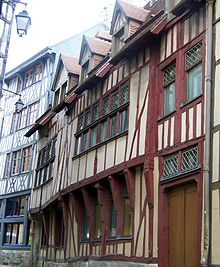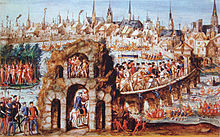History of Rouen
Rouen, France, was founded by the Gaulish tribe of Veliocasses, who controlled a large area in the lower Seine valley, which today retains a trace of their name as the Vexin.
After the reorganization of the empire by Diocletian, Rouen became the chief city of the divided province of Gallia Lugdunensis II and reached the peak of its Roman development, with an amphitheatre and thermae, the foundations of which remain today.
In the 10th century Rouen became the capital of the Duchy of Normandy and the residence of the dukes, until William the Conqueror established his castle at Caen.
[citation needed] The well-preserved remains of a medieval Jewish building, that could be a yeshiva, were discovered in 1976 under the Rouen Law Courts.
New work on the present Gothic cathedral of Rouen began, in the nave, transept, choir, and the lowest section of the lantern tower.
[5] A textile industry developed based on wool imported from England, competing with the northern County of Flanders and the Duchy of Brabant.
During the Hundred Years' War, on 19 January 1419, Rouen and its population of 70,000 surrendered[8] to Henry V of England, who annexed Normandy once again to the Plantagenet domains.
French soldier Alain Blanchard summarily hung English prisoners from the walls during the siege, for which he was beheaded; Canon and Vicar General of Rouen, Robert de Livet, excommunicated Henry V king, which occurred shortly after de Livet's own five year imprisonment in England.
In that same year, the young Henry VI was crowned King of England and France in Paris before coming to Rouen where he was acclaimed by the crowds.
The naval dockyards, where activity had been slowed by the Hundred Years' War, became busy again as did the church of Saint-Maclou, which had been founded under English occupation.
The salle des pas-perdus (a sort of waiting room or ante-room) of the present law courts was built during this time.
Cloth was exported to Spain who also provided wool, and the Medici family made Rouen into the main port for the resale of Roman alum.
At the beginning of the 16th century, Rouen became the main French port through which trade was conducted with Brazil, principally for the import of cloth dyes.
From 1560 onwards, tensions rose between the Protestant and Catholic communities, and the Massacre of Vassy triggered the first of the French Wars of Religion.
[11] The 16th and 18th centuries brought prosperity to the city through the textile trade and the increased use of port facilities, as well as the development of public transportation and other industries.
In June 1940, the area between the Rouen Cathedral and the Seine river burned for 48 hours as the Germans did not allow firemen access to the fire.
Other areas were destroyed between March and August 1944, just before and during the Battle of Normandy, which ended on the left bank of the Seine with the destruction of several regiments belonging to the German 7th Army.
[14] In August 1944, due to Allied advance, the Germans dissolved the subcamp and deported surviving prisoners to the Mittelbau-Dora concentration camp.




